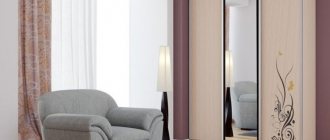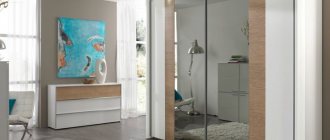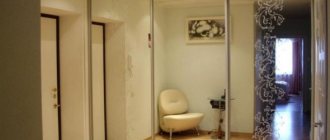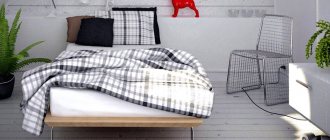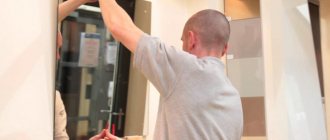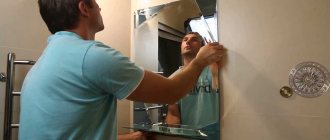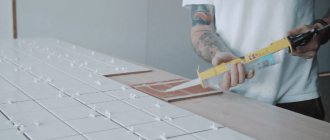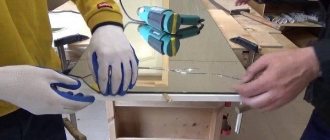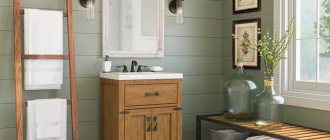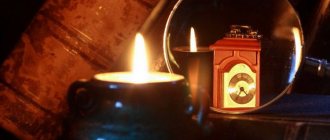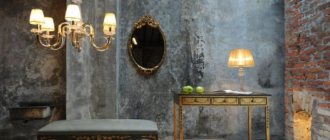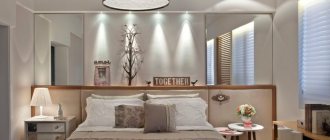Attaching a mirror to the wall with glue
For installation, a special glue is used, which is called “glue for mirrors”. They differ from ordinary ones in that they do not damage the amalgam coating. The important point is that the composition must have good adhesion (adhesion) to the surface on which you are going to glue the mirror.
- Moment Installation Liquid Nails. Made on the basis of synthetic rubber, it does not harden after drying and remains elastic. Suitable for application on wood, plaster, painted surfaces, metals. A 310 ml cartridge for a construction gun costs 160 rubles.
- SOUDAL 47A. Composition: synthetic rubber, suitable for gluing to concrete, brick, ceramic, and plastered substrates. It is characterized by a short curing time and has good adhesive ability. Contains a weak solvent that may damage poor quality amalgam. If you are in doubt about the quality of the coating, you should conduct a test before use. A 310 ml tube costs 190 rubles.
There may still be many compositions; the most common ones have been described. They "set" quickly, but final drying occurs only after 72 hours or more.
Some useful recommendations
Finally, I would like to give some more useful tips regarding the correct use of certain materials for fixing mirrors on vertical surfaces.
- If you plan to use special construction silicone with a transparent structure, be sure to degrease the walls and the back of the mirror with solvents before application;
- Try to avoid using any types of glue and mastics that smell reminiscent of the pungent aroma characteristic of glue. They contain certain components that can gradually deteriorate the state of the metal layer, that is, the amalgam. This is typical for some types of liquid nails. Be careful when choosing;
- There is no need to apply glue or mastic all over the back of the mirror. Apply several lines in a small, even layer along the entire length of the product. Try to maintain proportions so that there is no more glue in one part of the mirror than in the other;
- Titan type glue is applied to a previously degreased surface. You will probably need to buy a mounting gun separately, and therefore it is better to think about this in advance;
- It is recommended to apply glue starting from 2 centimeters from the edge, and make gaps of about 5 centimeters between the lines;
Special double-sided tape: where to buy, how to use?
The easiest way to attach it is with double-sided mounting tape. You should not buy the one sold in office supply stores. Household adhesive tape is designed for gluing paper or cardboard, it will not withstand heavy objects. Having glued the mirror with stationery tape, after just a few minutes you will have to remove the fragments from the floor - the tape will quickly peel off under its weight.
Which is better: heated floors or radiators?
Warm floorBatteries
For reliable fastening you need a special mounting tape - double-sided and foam. It is designed to hold sheet materials, including glass, and is sold in construction and automotive stores, with the second option being preferable. Automotive adhesive tapes are highly durable because they are used to fasten parts that are subject to high loads.
Which tape is best to take depends on the size and, accordingly, the weight of the mirror. The thickness of the tape should be in the range of 0.8–2 mm. The 3M brand has proven itself best.
What to do if the glass is glued crookedly? If tape was used, this is an easy fix. Using a thin string or fishing line, cut the foam part of the tape and remove the mirror, and then remove residues from the surfaces.
Using double-sided tape is easy and convenient. However, it should be taken into account that this method is not suitable for massive objects. You can attach a small mirror with adhesive tape; for full-length glass, it is better to use other fastening methods.
Expert opinion
Strebizh Viktor Fedorovich, leading construction foreman
It is only important to clarify whether the product contains a solvent; some of them absolutely cannot be used on mirror surfaces, as they quickly destroy the reflective layer. If you want to clarify something, please contact me!
Comments • 24
How long does it take to dry?
Daulet Zhadraev depends on liquid nails, more precisely on the layer, I leave it overnight
Solvent, strip, tape, why is all this needed? He placed the mirror on the surface, centered it, traced it with a pencil and applied silicone, put the mirror, aligned it with the mark, pressed it, and left it for a day. No amount of silicone will dissolve the enamel, what the hell?
The adhesive tape is needed so that the mirror does not move and there is no need to load it until it dries, so you left a comment, now someone read it and went to the barn on some boxes to glue the mirror and put everything heavy that is on the mirror, now the question for you is what will he succeed?
Hi all! Can you tell me the following question: there is a cabinet door made of 18mm chipboard (2300×840mm), and two mirrors (4mm) (the size of the mirrors are respectively half the door) will be glued to the height of the door, is there a gap between these mirrors, if so, what kind, and in general Is it possible to glue it like this, and what is the best way to glue it? thank you in advance!
Sergei Prushchik, if I'm not mistaken, this system has a maximum gate dimensions of 2500*1400 in chipboard, you will pass by weight, common sense is a relative concept))
@Chronicles of a Furniture Maker rollers: top-hung (the entire load goes to the top of the cabinet, as I understand it) glatt sliding system from starke, the dimensions of the door leaf, according to the manufacturer, are limited by common sense))
and is this a wardrobe door? if in an aluminum profile, then remove the chipboard and assemble it with a mirror with an insert.
Sergei Prushchik it is possible to glue it, as in the video, it is better to make a gap of at least 0.5 mm so that the glass does not rub against each other, or use double-sided tape like silicone or just silicone so that the joint does not become clogged with dust and does not creak later, of course, ideally you also know what brand the rollers are from and find out what maximum load they can hold
Like. Everything is beautiful and accessible! I have a question. I assembled the kitchen. All that remains is to make the facades. I can’t imagine which ones exactly. So the idea came to mind to make completely mirrored ones. Without any frames. It turns out that you will have to glue it using this method. Can you tell me, how practical is this in the kitchen? Or well what for?
Andre Chop please
@Chronicles of the Furniture Maker thank you very much.
For a kitchen, this is not a practical option at all: 1) the heavy weight of the façade immediately requires the fittings 2) the open end of the glass (mirror) which is also not good 3) an open adhesive seam into which dust and moisture will get in 4) a backing that is cut at the edge is the most a minimum of disadvantages, in this case I would still recommend an aluminum frame profile of this type makmart.ru/WItem/12247/ with a minimum shelf
There is a two-component glue, such as moment, with a hardener. If you position the mirror clearly, it should stick very quickly. There is a question, if you need to reach the level with a facade of 18 mm, then which mirror and chipboard should you take?
@Chronicles of the Furniture Maker might not have responded. It’s unlikely that I would have lost anything)))
everything is relative. What kind of question is this answer)) +/- a couple of mm can be set
@Chronicles of a Furniture Maker “don’t reach the level”, what kind of news is this?) That is, you can’t make a door with 18-19 mm chipboard and adjust the facades?
1) I’m not in a hurry to do a quick gluing 2) I’m not trying to find a universal adhesive 3) don’t go to the level, chipboard in thickness 10,16,18, etc.
Please tell me why they glue a mirror onto chipboard?
@Furniture Maker Chronicles thanks for the quick response buddy!
Sofa Kritic has many different cases, the facade (door) is made of chipboard and there needs to be a mirror, tables for makeup artists and hairdressers, or the design needs more rigidity, this is so without going into details
Source: rucams.net
How to glue a mirror to a cabinet with your own hands: double-sided tape, liquid nails and other means
- Staples. They have a U-shape, where one side, which will capture the reflective side, is shorter than the other. Holes are drilled in the cabinet door and self-tapping screws are inserted. The staples are hung on self-tapping screws, and then the mirror is inserted.
- Through holders. There are remote ones, moving the mirror away from the surface of the door, and adjacent ones. They are a fastening structure, on one side of which there is a chrome plated cap. This cap will hold the mirror on the base attached to the door with self-tapping screws. This method involves drilling a hole in the mirror. To do this you will need a special tool with a diamond drill.
- Furniture fasteners. Design with plugs, which are installed at the top and bottom. If necessary, it can also be attached to the sides.
Required materials and tools
The key to successful work is the use of exclusively high-quality materials. First of all, you need to purchase special silicone for mirrors and glass at a hardware store.
Silicone for mirrors
Next we will need a composition for degreasing the surface. You can use white alcohol or another universal solvent. And of course, buy a mirror of the right size or order it from a glass workshop.
Tools that will be useful:
- gun for applying silicone;
Silicone gun
tape measure or large ruler;
Roulette
- screwdriver;
Screwdriver rags for applying degreaser;
Rag and degreaser
- weight to press the mirror material against the door.
What should you consider when choosing a mirror mounting method?
The choice of mirror mounting method is influenced by several factors:
- Mirror size. Large full-length mirrors are best hung on mechanical fasteners. Small ones - for the face or up to the middle of the body - can be hung with tape, glue or liquid nails.
- Cabinet location. If it is located in the bathroom or kitchen, where it is constantly hot and humid, you need to choose a moisture-resistant and heat-resistant adhesive composition.
- Cost of materials. All proposed types of fastenings are quite cheap.
- Skills of the master and availability of the necessary tools. Not every home has a screwdriver, is it worth buying one just to screw a mirror? It is also worth choosing the method that the master can handle.
Whatever fastening method is chosen, the main criterion should be reliability. You should make sure that the mirror is firmly glued to the surface, and only then hang the door back on the cabinet.
Suitable adhesives for mirrors
Neutral silicone sealant for mirrors is a good option; it is perfect for working with decorative canvases.
It is only important to clarify whether the product contains a solvent: some of them absolutely cannot be used on mirror surfaces, as they quickly destroy the reflective layer. Information about the suitability of a particular sealant is on the packaging.
As for the best brands of liquid nails that can be purchased for gluing mirrors, the following should be mentioned:
- MACROFLEX MF 930. Suitable for decorative, mosaic mirrors up to 6 mm thick when attached to concrete, glass, tiles. It is stable in a humid environment, withstands temperature changes of up to -5...+60 degrees, and does not spoil the amalgam.
- KRASS “Liquid nails”. Glues mirrors in any room, suitable for mirror tiles, including when attached to deformable bases. It sets quickly, does not flow from vertical surfaces, and has a high degree of adhesion.
- "Titanium for mirrors." Adhesive based on rubber, synthetic resins. Can glue mirrors of almost any thickness to drywall, wood, concrete, brick, and metal. Does not provoke corrosion and does not damage non-ferrous metal products. The elastic seam is not destroyed by deformation or temperature changes.
Attaching a mirror to the wall: installation methods, types of fasteners
The final touch is to remove the protective film from the glued pieces and install the mirror in its intended place. Manufacturers of this type of tape provide a guarantee for 10,000 adhesives, so if it is installed incorrectly, you can correct it.
Expert opinion
Strebizh Viktor Fedorovich, leading construction foreman
It is not worth gluing along the perimeter; it is better to glue all the pieces vertically in a checkerboard pattern at a distance of about 10-12 cm from each other. If you want to clarify something, please contact me!
The best adhesive composition
Many craftsmen claim that the best glue for mirrors is silicone sealant. There are two reasons for this:
- Resistance to external irritants. For example, dust, temperature fluctuations, humidity and other factors.
- This composition is of very high quality - it has a long shelf life, it is tensile strength, mobile, hard, and also has a high density
Important! What should we know about silicone sealants? They are all vulcanized materials that are designed to seal.
Classification of silicone sealants
Such compositions can be classified as follows.
When ready for use:
- There are one-component sealants. This means that they are ready for immediate use.
- Two, three or more components. This means that they must be mixed before use.
Based on composition:
- Made from silicone.
- Polyurethane.
- From thiokol (polysulfide).
- Made from acrylic.
Important! The compositions were listed in descending order of qualities useful in construction.
Sealants in construction
So is it possible to glue a mirror with silicone sealant? The answer is yes. It is not surprising, since silicone sealants are widely used in construction work.
Important! It is also worth noting that sealants are widely used in structural glazing - they are used to strengthen materials for glazing facades and windows. Sealants are also often used as construction putty.
Silicone adhesives have many advantages:
- UV resistance.
- Resistant to changing weather conditions.
- Resistance to aggressive environments.
- High adhesion to many types of building materials. You don't even need to use a primer (primer).
- Excellent motion accommodation.
- Valid at any temperature.
- They have a complex composition.
How to glue a mirror to chipboard? Tips for all occasions
- construction – used for sealing cracks, chips, sealing frames, fastening various structures, containing neutral reagents as hardeners;
- roofing – resistant to atmospheric factors, ideal for outdoor work, not afraid of water;
- plumbing – additionally contain antiseptics, fungicides, and are moisture resistant;
- universal - boast a high degree of adhesion to most known materials, but rarely have antiseptic properties and good moisture resistance;
- hydraulic - recommended as seals when working with cast iron, aluminum, ceramic parts;
- glass - suitable for glossy substrates - glass, ceramics.
Proper use of liquid nails
The sealant must be used together with a special gun into which the cylinder is inserted. First, you need to cut off the tip of the tube and screw on the dispenser that comes with the kit. The base and mirror should be cleaned, degreased, dried, and only then glue should be applied.
To place the mirror evenly, you need to mark the wall - draw a straight line where the bottom of the product will go. A temporary support should be placed here to prevent it from slipping until the glue dries. If this is not possible, you will have to fix the mirror with tape from the front side.
You need to remove the protective paper from the decorative fabric (peel it off from the reverse side), apply glue along the perimeter and diagonally. Wait 1-3 minutes, attach the mirror to the wall, press well. Immediately remove excess glue with a wet cloth, as you will have to scrub it off with great difficulty later.
Typically, the support or adhesive tape for fixation is removed after a day, but at low room temperatures, the glue drying process can last up to 48 hours.
How to treat the surface → Room decoration → How to choose the right paint → Surface treatment technologies → Leveling and finishing the walls → Selecting and applying a primer → Removal from the surface → Stretch ceilings and technologies → Reviews and testimonials
How to glue two mirrors
Mirrors can be glued together using surfaces and edges. The first option is relevant when the old product cannot be removed, but the interior needs to be updated. The second is if it is necessary to increase the mirror area.
You need to carefully stick one mirror onto another. First, both elements are degreased. Then glue for mirrors is applied (to both products around the perimeter), after which they are pressed against the wall or furniture facade. It is advisable to treat the end gaps with sealant.
If it is necessary to glue mirror surfaces, it is important to select 2 identical parts. How to glue a mirror so that it does not burst in the future - you need to precisely adjust the edges, first clean the sides of dust and dirt, and degrease them. It is necessary to glue carefully so that the glue does not protrude out. You can hang one part first and glue the other to it. Another option is gluing mirrors outside the wall. The structure will be fragile, so it is not advisable to move it.
